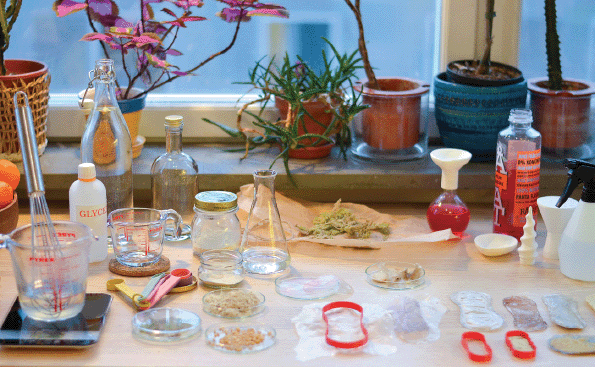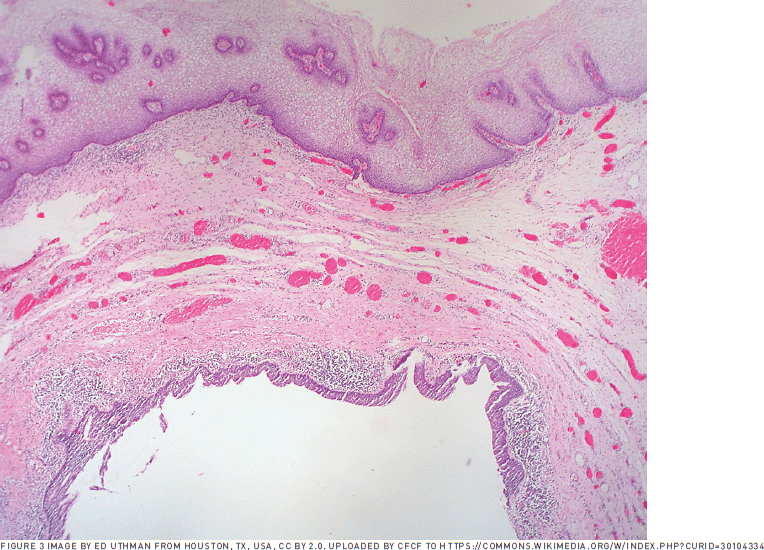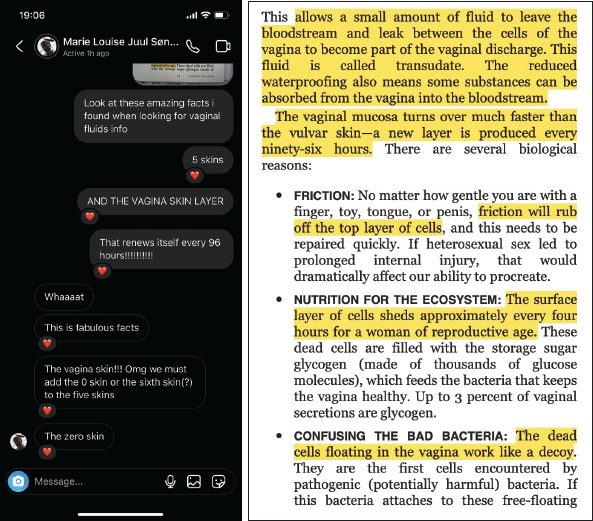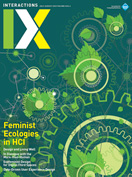Authors:
Nadia Campo Woytuk, Marie Louise Juul Søndergaard
Between 2021 and 2022, we immersed ourselves in a very personal and caring design process for our newly funded project, Biomenstrual. In the project we sought to explore sustainable menstrual care, speculating on how human menstrual cycles might touch and be touched by more-than-human actors in many ways: from the species used to source biodegradable materials that we might make absorbent pads and tampons from, to the soil and decomposers ready to break down and feed on discarded menstrual blood. We wondered how our menstrual cycles are entangled with soil, plants, microbes, and beyond, and how such relations might inspire us to design more caring and sustainable menstrual practices [1].
→ Biomenstrual is a Research through Design project for imagining, designing, and practicing menstrual care beyond the human body.
→ Designing from somebody, somewhere is an ecofeminist practice of designing situated embodied interventions and generating situated knowledges.
→ Calling attention to neglected and stigmatized relations between bodies and ecologies can be a way to practice ecofeminist design.
Below we present memories in the shape of semi-fictitious fragments of our personal diaries during the design process of Biomenstrual. These fragments are neither exhaustive nor finished, but point to ways in which our own bodily functions, the local ecosystems that we live in and design from, and social relations and coincidences external to our project all influenced and made up the design research.
These fragments contribute to a story of ecofeminist design; of ecological thinking in menstrual health, and bodies and well-being as core ecofeminist issues. As feminists we ask, how can caring for one body extend to caring for the bodies of many, including nonhumans?
How might we design for individual care in a way that it becomes planetary care [2]?
 Nadia, March 15, 2021, Stockholm, Sweden
Nadia, March 15, 2021, Stockholm, Sweden
A big red label marked PERIOD strikes out the whole week in my calendar. Tasks this week include: "blood experiments" on Monday and Tuesday, "collect moss" on Wednesday, "moss knitting experiments" on Thursday, "buy soil" on Friday. A sense of urgency fills my body. These days are precious to our research project: I only have access to my blood, my menstrual experiences, and my bodily materials once a month, or not even that often, due to irregularities in my cycle. But maybe there is a positive spin to it? I don't seem to notice the pain, the bloating, and the grumpiness as much anymore. I anticipate and look forward to these days. Next week I will tell Marie Louise. Other calendar tasks during March 2021:
"check sourdough"
"antigen test"
"bring petri dishes"
"gyno appointment"
"plant experiments"
"read texts"
"check kombucha"
"climbing"
"dinner with friends"
"fix bike"
 Marie Louise, May 24, 2021, Vestjylland, Denmark
Marie Louise, May 24, 2021, Vestjylland, Denmark
I had arrived at my mother's cabin on the Danish west coast. My relocation plans to Norway had been interrupted by its xenophobic pandemic border closure, and after months of waiting, of being stuck in Stockholm, it was time for a change. While I missed working next to Nadia, the endless open ocean and kilometers of beach provided calmness, familiarity, and a momentary sense of freedom in the absence of people. Walking to the small lake in front of my cabin, I noticed what Nadia and I had spent hours, often without much luck, searching for in Stockholm ecologies. The star-shaped and neon green body, only a few centimeters tall, growing at the edge of the lake. That certainly was sphagnum moss, the species that Robin Wall Kimmerer had taught us that women have been using throughout centuries as menstrual pads [3]. There it was, slowly growing, purifying the water and cleaning the air. I took a small handful, only what I needed to start prototyping a moss menstrual pad.
There it was, slowly growing, purifying the water and cleaning the air. I took a small handful, only what I needed to start prototyping a moss menstrual pad.
 Nadia, October 19, 2021, Stockholm, Sweden
Nadia, October 19, 2021, Stockholm, Sweden
Bustling city noises became the soundtrack to our daily trips, sprinting to catch the bus. Marie Louise, who was visiting Stockholm for the week, was rushing beside me with an Ikea bag full of clinking petri dishes, bioplastic samples, a bag of dirt, printed photos, strings, and labels. We were headed to the gallery to set up our exhibition. As we made haste, I looked down and saw a familiar shape: A discarded unused menstrual pad (a panty liner, to be precise) was on the sidewalk at my feet. I thought of it as a fun coincidence, since we were carrying samples of our own prototypes for biodegradable menstrual pads. I quickly grabbed it and added it to the bag.
 Nadia, October 20, 2021, Stockholm, Sweden
Nadia, October 20, 2021, Stockholm, Sweden
Today while setting up we noticed the menstrual pad we had picked up off the street. It had spent the night in the cold and humid shipping container that was our exhibition space. The pad was strangely puffy and squishy, it had doubled in thickness. Amazed but also concerned, we knew exactly what it was: The microplastic powder (superabsorbent polymer) present in most menstrual care products had absorbed the water from the air. We cut open the pad, eager to witness the swollen plastic with our own senses, confirming what we already suspected: a handful of gel-like microplastic waste.
 Marie Louise, October 24, 2021, Stockholm, Sweden
Marie Louise, October 24, 2021, Stockholm, Sweden
At the beginning of our workshop, we gave all participants a small test tube and invited them to gather samples to look at under a microscope (Figure 1). Our workshop co-organizer, Murilo Polese, brought a fantastic sample from a small pond. Nadia and I had told him about our fascination with the tardigrade, a microscopic creature living in sphagnum moss. Sharing our fascination, we searched through the pond sample for a tardigrade. The sample revealed a microcosmos; as we blasted it on a big screen, we all looked carefully. We did not find the tardigrade but instead found its less-known sibling, the rotifer! I wondered if the rotifer, like the tardigrade, also thrives in the moss we would put close to our vagina. If it also lives on our skin, on our eyelashes. As we used the microscopes to search through living plants, zooming in closely on our skin, tattoos, textiles, and hair, whole new worlds appeared. There is so much life in front of us, if we would just pay close attention and look intimately with our curiosity. Would the tardigrade thrive in our menstrual-blood-infused moss pads? Or does it already thrive in the acidic vaginal flora?
 | Figure 1: Microscopic detail of sphagnum moss. |
 Nadia, March 14, 2022, Barcelona, Spain
Nadia, March 14, 2022, Barcelona, Spain
My menstrual tracking app says my cycles are "highly irregular." My fertile period doesn't happen always at the same time every month. It doesn't happen every 14th day of my cycle; it doesn't even happen every cycle. I am visiting the city where I grew up (Barcelona) and today I walked by the road I used to go for runs on. I remembered how my roommate and I would end up coughing and out of breath after those runs, until it dawned on us that we were jogging up and down one of the city's most traffic-heavy roads. I wondered why we did that, what kinds of pollutants were absorbed by my body, and how long these strange materials inhabited my lungs and whether they traveled to other parts of my body. I remember the headlines: "Air Pollution Significantly Raises Risk of Infertility, Study Finds" and "Could Air Pollution Be Affecting Your Menstrual Cycle?" There are so many things about my body I do not know.
 Marie Louise, March 16, 2022, Oslo, Norway
Marie Louise, March 16, 2022, Oslo, Norway
I received a message from my mom: "Muffi just started bleeding—again! Could you research some kind of protection for dogs in heat? Anything that can collect blood, and preferably reusable, that should be the most sustainable." I remember my childhood dog, who would walk around in the house with dog underwear, sometimes dripping blood on the wooden floor, which I would quickly wipe away. I miss her. Our new dog is also lovely. My stepdad said she had gotten even more caring and cuddly during the time of her first bleeding. Is it even possible to get any cuter?
 Nadia, Marie Louise, and friends, April 12, 2022, Växjö, Sweden
Nadia, Marie Louise, and friends, April 12, 2022, Växjö, Sweden
It is soon Easter, so as an icebreaker during our workshop "Fertility & Fertilizers" we decided to go around the table and share traditions of, anecdotes about, and associations with Easter. Easter is a time of abundance and an ode to fertility. Eggs. I remember Easter as a scary thing, with processions and hooded men. Christianity adopted pagan rituals. Blood and sacrifice. That's why the eggs are red! Roasted lamb. Witches flying to Blåkulla (Blue Hill). Chocolate. There is this old controversial tradition where boys "whip" girls with pussy willows. Why? For good health and fertility! What?! Then we should reclaim the pussy willow! Let's weave them into baskets instead of whips.
 Designing from Somebody, Somewhere
Designing from Somebody, Somewhere
Thinking back to the times of the project, remembering and writing the fragments above, makes us aware of how closely situated and embodied we were, and still are, in the ecosystems with(in) which we design. The pandemic forced us to move out of our offices and workshops and into our homes, setting up labs for making in our kitchens (Figure 2) and rethinking what materials to design with. The health crisis made us hyperaware of our bodies and surroundings, and how also our menstrual cycles are intimately entangled with the more-than-human worlds. While uncertainties were exacerbated, doing this project became a way for us to situate our bodies and beings; it became a way of designing from somewhere. Entangling bodies in ecology could be how "design work becomes located" [4] in body, time, and space, rather than an "objective and neutral" practice. For example, such situated and embodied practice is experienced in stumbling in the street upon the very reason you started this project in the first place, or finding a familiar species of moss in an unexpected place, which feels like meeting an old friend. We used our own menstruating bodies as a first-person approach to notice and design for more-than-human relations. Air pollution, rotifers, dogs, microplastics, pussy willows—an endless and ongoing number of relations opened up to us, the more we looked. Designing from somebody, somewhere became our ecofeminist practice of designing situated embodied interventions and generating situated knowledges.
 | Figure 2: Making biodegradable menstrual pads in the kitchen. |
The ecological and nonhuman relations that we observed and opened up to were not only necessarily wanted or innocent. We were curious how the relations we enabled, highlighted, and strengthened were thriving or being harmed by our design work. Will the rotifer thrive in mosses that were soaked in menstrual blood? Will the menstruating body be harmed running next to the highway? Will sphagnum moss keep growing after we take some? While numerous questions arise, we cannot always know the answers, and sometimes what we need in ecologically minded research that involves designing with nonhumans is a speculative ethics of care [5]. Our human body is already made up of so many nonhuman cells that most of our being is not human. Bacteria, viruses, and fungi, such as yeast, are the nonhuman makeup of the body. An ecosystem within an ecosystem. Perhaps by noticing our own bodily biodiversity, we might learn to scale our care for larger biodiversities.
 Designing for Neglected Relations and Tensions
Designing for Neglected Relations and Tensions
In the tangled mossy messing around, we found ourselves noticing unexpected relations, relations that have long been neglected, unknown, or ignored, yet appear to be crucial for life on Earth. These relations are tensions, such as how pollution and toxicities (e.g., plastics in menstrual products) affect menstrual health, and how (hu)man-designed menstrual products pollute the environment. Making connections between seemingly unlike bedfellows—menstrual blood and soil, vaginas and tardigrades—encouraged what-if questions and speculations about how such relations could revitalize our healthy bodies and our healthy being on Earth. Sometimes we made these tensions and relations bold, and perhaps we even exaggerated the associations, because how can two designers answer the question "How is my menstrual health affected by the climate crisis when medical and environmental scientists do not even have the answers?" Perhaps what we can do, as designers, feminists, and HCI researchers, is claim the importance and open up the space for further emphasis on exploration, on the urgency, that this matters and we need to figure out how.
With our memories and reflections, we want to show how the world around us leaks into our research and our bodies, and how we leak back into our worlds.
With our memories and reflections, we want to show how the world around us leaks into our research and our bodies, and how we leak back into our worlds. How our designs leak into our homes, our cities, our ecosystems, and how the ecosystems leak into our designs. In the Western world, there is much focus on and status around containing ourselves. Perhaps our bodily fluids are the only flaw of our otherwise fully contained body, which has fooled many into believing that we humans should be separate from our environment. But even our skin, something often thought of as a layer that keeps our body contained and separate from our surroundings and from nature, is porous and permeable and inhabited and constituted by nonhuman microorganisms. If there are no boundaries to the body, are we even separated from nature, or do we live in what Kimmerer calls "a web of reciprocity" [3] with the beings we call nature? The "Men's Five Skins" framework (1998) by artist, architect, designer, and ecologist Friedensreich Hundertwasser was a proposal for narrating new ways for humans to interface with the environment, where the five skins are formed by the epidermis, clothing, buildings and houses, identity, and the planet [6]. While not fully abandoning the original curious ideas by Hundertwasser, we want to highlight that these skins do not get very close to the actual skin and intimate areas of the human body, and add that something very interesting can be learned if we integrate a "zero skin." For our project, this might be the porous, leaky, and regenerative skin of the vagina (see Figures 3 and 4). While the metaphor of the five skins is an interesting and generative vision of how the layers of different life-forms on the planet permeate and entangle with one another through our porous skins, Hundertwasser kept with the binaries, including that of gender, when articulating this metaphor: "men's five skins," where the outmost skin is related to nature, urging man to "learn how to communicate with her" [6]. The man/woman and culture/nature binary persists, where man as the center of the universe is surrounded by feminine-coded nature. An ecofeminist approach to skins would instead seek to trouble those binaries, and could ask: What would happen if we added the intimate skin (of, for example, the vagina) to the existing five skins of "man"? Figure 5 is our response as ecofeminist six skins.
 | Figure 3: Vaginal epithelium (inner lining of the vagina). Gartner Duct Cyst (low power). |
 | Figure 4: Screenshots of an online conversation between the authors [left] and a highlighted section from The Vagina Bible by Jen Gunter [right]. |
 | Figure 5: An ecofeminist six skins. Nadia Campo Woytuk and Marie Louise Juul Søndergaard, 2023. |
 Onward with Ecofeminist Design for More-Than-Human Bodies
Onward with Ecofeminist Design for More-Than-Human Bodies
With this dialogue, we want to bring attention to the more-than-human materialities and agencies that participate in and influence a bodily-centered design process, whether it is the proliferation of a species of moss in your new surroundings, encountering memories of polluted airs, or the availability of your own bodily fluid to perform experiments. Doing ecofeminist design implies attending to our curious nonhuman relations and designing with them in ways that trouble oppressive systems and care for the health and well-being of humans, nonhumans, and the environment.
Biomenstrual is a case of what ecofeminist HCI could be, and an example of what ecofeminist design might look and feel like. With the fragments, we explore how ecofeminism and, more broadly, feminist approaches to ecology and environment are more a philosophy of life or set of values than a method for design, and perhaps that is why our memories bleed in and out of our personal lives, our bodies, and our designs.
Caring for menstrual health is caring for environmental and climate health—when doing ecofeminist design centered around human care, we (inevitably) notice and care for more-than-human agencies in the process. Together with many in the HCI and design community, we are fascinated by how first-person, body-centered design processes are infiltrated by more-than-human agencies. We hope our stories, questions, and concerns about an ecofeminist-inspired design process can be generative for designers and HCI researchers working with these bodily-centered practices, extending beyond menstrual care to a wider range of topics on human health and well-being.
1. Campo Woytuk, N. and Juul Søndergaard, M.L. Biomenstrual: More-than-human design of menstrual care practices. Temes de Disseny 38 (2022), 116–131; https://doi.org/10.46467/TdD38.2022.116-131
2. Wilde, D., Del Corral, A., Silvestre, E., and Ceballos, R.G. Caring through design: A search for new perspectives. Temes de Disseny 38 (2022), 8–19; https://doi.org/10.46467/TdD38.2022.8-19
3. Kimmerer, R.W. Gathering Moss: A Natural and Cultural History of Mosses. Oregon State Univ. Press, Corvallis, OR, 2003.
4. Suchman, L. Located accountabilities in technology production. Scandinavian Journal of Information Systems 14, 2 (2002), 7.
5. de la Bellacasa, M.P. Matters of Care: Speculative Ethics in More than Human Worlds. Univ. of Minnesota Press, Minneapolis, 2017.
6. Jakobsen, O. and Storsletten, V.M.L. Friedensreich Hundertwasser—The Five Skins of the Ecological Man. In Art, Spirituality and Economics: Liber Amicorum for Laszlo Zsolnai, 2018, 39–50.
Nadia Campo Woytuk is a Ph.D. student at KTH Royal Institute of Technology. Her work focuses on critical and intersectional feminist design of technologies for menstrual health and intimate care. She has led and contributed to projects involving new media art, textiles, software art, and postcolonial computing. Her current work explores touch and sense-making of the intimate body and the social and environmental ecologies it entangles. [email protected] www.nadiacw.com
Marie Louise Juul Søndergaard is an interaction designer and design researcher. Her research explores feminist and speculative design of digital technologies for menstrual, reproductive, and sexual health. She is a postdoc at the Oslo School of Architecture and Design, previously at KTH Royal Institute of Technology, and holds a Ph.D. in interaction design from Aarhus University. [email protected] www.mljuul.com
 Copyright 2023 held by owners/authors
Copyright 2023 held by owners/authors
The Digital Library is published by the Association for Computing Machinery. Copyright © 2023 ACM, Inc.








Post Comment
No Comments Found